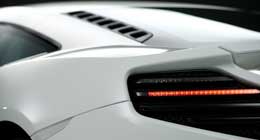| |
- حریدیها، نتانیاهو را تهدید کردند
- رجی: اروپا مذاکرات با ایران را به پرونده هستهای محدود نکند!
- پیگیری مشکلات و مطالبات معلمان
- رهبر حماس: تایید شده که حماس حتی یک بار هم توافق را نقض نکرده است
- اعمال تغییرات جزئی در سند مواد پیشرفته
- موشک «اطلس ۵» ماهوارههای «آمازون» را راهی مدار زمین کرد
- آغاز اردوی تیم ملی هندبال مردان با حضور لژیونرها
- آنفلوآنزا در ۸ استان بالاتر از حد هشدار
- بازداشت یک سرکرده داعش توسط سرویس امنیت ملی عراق
- بازپخش سریال «بوقچی» از امروز
- بلژیک به پیشنهاد اتحادیه اروپا علیه روسیه «نه» گفت
- یک ایستگاه لرزهنگاری باند پهن وارد مدار مؤسسه ژئوفیزیک شد
McLaren planning F1 successor, three additional models

McLaren Automotive, the reborn company that once laid claim to creating the world’s fastest car – the F1 – plans to build a successor to its original supercar and much, much more.
According to KHABAR KHODRO, Rather than simply producing a single car like McLaren did in the past, the company now intends to create an entire range of vehicles that will simultaneously be available on the market, according to Motor Trend, serving several different price points.
To make that happen McLaren has at least four new models beyond the MP4-12C in the works, each of which will fit into one of three tiers, and each tier will have the potential for coupes and cabriolets. The current lone vehicle, the MP4-12C, codenamed P11, will sit in the middle of the product range, doing battle with the Lamborghini Gallardo and Ferrari 458s of the world.
Sitting above the P11 will be the (you guessed it) P12, a supercar intended to perform on the same level as the Lamborghini Aventador or akin to the original F1.
Counter-intuitively, the model sitting below the P11 will be the P13. The P13 will do battle against the likes of the high-volume Porsche 911 (non-turbo).
To date, McLaren Automotive has burned through about $400 million with the development of the MP4-12C, including building 73 prototypes, driving some 625,000 development miles and arriving where the company is today. That figure, according to Antony Sheriff, managing director, “doesn’t include the factory,” which comes in at an additional $63 million.
Sheriff goes on to explain that each of the additional future models will be “true McLarens,” based on carbon-fiber monocells and with the goal of offering best-in-class handling and performance in their respective segments.
One huge benefit to this approach is the cost savings on crash testing, something already handled thanks to the eight prototypes built specifically for that purpose with the P11. Do keep in mind, however, that while the tub is carbon fiber, the front, rear and roof frames, crash structures, hood, front fenders and roof are aluminum, while other aspects of the car are composite-based.
Since so much of the rigidity in the P11 comes from the monocell, that allows for open-tops variants without losing rigidity, dramatically helping to reduce vehicle weight and improve handling.
The first new model to come will be the grand daddy of them all, the P12, which will pick up the torch where the F1 left off. Expect this car to boast horsepower in the 800+ range while retaining the weight of the P11, thanks to an increased use of carbon fiber.
Frank Stephenson, design director at McLaren, says that the models will not look like slightly modified or larger or smaller examples of the P11, but there may be certain design elements that will be common across the models to provide for brand identity. Examples would include: dihedral door hinges, the greenhouse, a low cowl for strong forward visibility, hidden rear taillamps and even more detailed headlamps.
McLaren has the capacity to produce about 4,000 cars a year, and with 1,300 examples of the P11 planned, that leaves room for about 2,500 P13 models and at most 200 examples of the P12.











